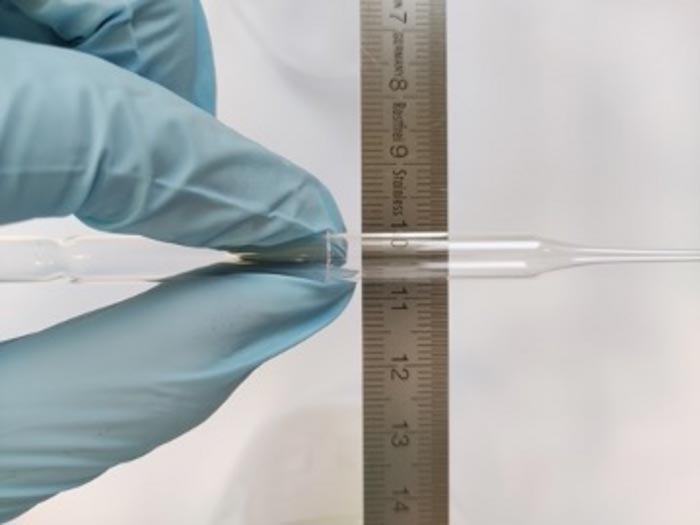First single-crystal organometallic perovskite optical fibers

Single-Crystal Organometallic Perovskite Optical Fiber
Credit: Dr Lei Su
The high-performing fibers could speed-up broadband delivery, improve medical imaging and even make solar powered clothing.
Due to their very high efficiency in transporting electric charges from light, perovskites are known as the next generation material for solar panels and LED displays. A team led by Dr Lei Su at Queen Mary University of London now have invented a brand-new application of perovskites as optical fibres.
Optical fibres are tiny wires as thin as a human hair, in which light travels at a superfast speed – 100 times faster than electrons in cables. These tiny optical fibres transmit the majority of our internet data. At present, most optical fibres are made of glass. The perovskite optical fibre made by Dr Su’s team consists of just one piece of a perovskite crystal. The optical fibres have a core width as low as 50 μm (the size of a human hair) and are very flexible – they can be bent to a radius of 3.5mm
Compared to their polycrystal counterparts, single-crystal organometallic perovskites are more stable, more efficient, more durable and have fewer defects. Scientists have therefore been seeking to make single-crystal perovskite optical fibres that can bring this high efficiency to fibre optics.
Dr Su, Reader in Photonics at Queen Mary University of London, said: ‘Single-crystal perovskite fibres could be integrated into current fibre-optical networks, to substitute key components in this system – for example in more efficient lasing and energy conversions, improving the speed and quality of our broadband networks.’
Dr Su’s team were able to grow and precisely control the length and diameter of single-crystal organometallic perovskite fibres in liquid solution (which is very cheap to run) by using a new temperature growth method. They gradually changed the heating position, line contact and temperature during the process to ensure continuous growth in the length while preventing random growth in the width. With their method, the length of the fibre can be controlled, and the cross section of the perovskite fibre core can be varied.
In line with their predictions, due to the single-crystal quality, their fibres proved to have good stability over several months, and a small transmission loss – lower than 0.7dB/cm sufficient for making optical devices. They have great flexibility (can be bent to a radius as small as 3.5mm), and larger photocurrent values than those of a polycrystalline counterpart (the polycrystalline MAPbBr3 milliwire photodetector with similar length).
Dr Su said, ‘This technology could also be used in medical imaging as high-resolution detectors. The small diameter of the fibre can be used to capture a much smaller pixel compared to the state of the art. So that means by using our fibre so we can have the pixel in micrometer scales, giving a much, much higher resolution image for doctors to make better and more accurate diagnosis. We could also use these fibres in textiles that absorb the light. Then when we’re wearing for example clothes or a device with these kinds of fibre woven into the textile, they could convert the solar energy into the electrical power. So we could have solar powered clothing.’
Journal: Science Advances
DOI: 10.1126/sciadv.abq8629
Article Title: Single-Crystal Organometallic Perovskite Optical Fibers
Article Publication Date: 23-Sep-2022
Media Contact
Melissa Bradshaw
Queen Mary University of London
m.bradshaw@qmul.ac.uk
All latest news from the category: Materials Sciences
Materials management deals with the research, development, manufacturing and processing of raw and industrial materials. Key aspects here are biological and medical issues, which play an increasingly important role in this field.
innovations-report offers in-depth articles related to the development and application of materials and the structure and properties of new materials.
Newest articles
Faster, more energy-efficient way to manufacture an industrially important chemical
Zirconium combined with silicon nitride enhances the conversion of propane — present in natural gas — needed to create in-demand plastic, polypropylene. Polypropylene is a common type of plastic found…

Energy planning in Ghana as a role model for the world
Improving the resilience of energy systems in the Global South. What criteria should we use to better plan for resilient energy systems? How do socio-economic, technical and climate change related…

Artificial blood vessels could improve heart bypass outcomes
Artificial blood vessels could improve heart bypass outcomes. 3D-printed blood vessels, which closely mimic the properties of human veins, could transform the treatment of cardiovascular diseases. Strong, flexible, gel-like tubes…





















